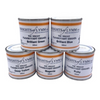Gold Lead Across the World - Poland
- by Sam Wozniak
The Shimmering Legacy of Gold Leaf in Poland: History, Uses, and Restoration
Gold leaf — known in Polish as złota folia — has played an enduring role in Poland’s religious, cultural, and artistic heritage. From medieval icons and royal palaces to modern-day restoration (renowacja) projects and contemporary art, the application of goldleaf (złota folia) continues to be both a traditional craft and a symbol of spiritual and national significance.
This article explores the fascinating history and ongoing use of 24 carat (24-karatowa) and 23.5 carat (23,5-karatowa) gold leaf in Poland, with a focus on gilding (pozłacanie), monumental architecture (architektura monumentalna), and cultural preservation.
A Brief History of Gold Leaf in Poland
The use of gold leaf in Poland dates back to the early Middle Ages, closely tied to the Christianization of the country in the 10th century. Churches and monasteries across the Piast and Jagiellonian dynasties were adorned with lavishly gilded elements, often imported from Western Europe or produced by local craftsmen trained in Byzantine and Gothic traditions.
During the Renaissance and Baroque periods, gilding (pozłacanie) reached new heights. Artists and artisans began applying 23.5 carat gold leaf (złota folia 23,5-karatowa) to wood, stucco, and canvas, embellishing everything from altarpieces to royal portraits. In this period, Poland’s nobility and clergy used gold leaf extensively to demonstrate both spiritual devotion and social status.
One of the most famous historical examples is the Wawel Cathedral in Kraków. Its chapels and altars include extensive gilded ornamentation, representing centuries of religious and political power. Gold leaf was also used in sacred icons, manuscript illumination, and religious relics — a tradition deeply rooted in Eastern Orthodox and Catholic practices across Central and Eastern Europe.
Gold Leaf in Monumental Polish Architecture
Poland’s monumental architecture — especially its churches, cathedrals, and castles — showcases the enduring power of goldleaf. In particular, the Church of St. Anne in Warsaw and the Church of Saints Peter and Paul in Kraków feature spectacular uses of gilded woodwork and stucco.
These elements are often covered in 23.5 carat gold leaf, which provides durability while maintaining a brilliant appearance. In some cases, 24 carat gold leaf (złota folia 24-karatowa) is used for its unmatched purity and lustre, especially on focal points like high altars or saintly halos.
The function of gold leaf in these monumental settings was not merely decorative — it was symbolic. Gilding reflected divine light, eternal glory, and the connection between heaven and earth. In a time before electric lighting, the way gold shimmered in candlelight enhanced the sense of awe and sacredness within these monumental structures.
Restoration and Preservation in Modern Poland (Renowacja i konserwacja)
Today, the use of gold leaf in Poland is experiencing a revival, particularly in the field of restoration (renowacja). Many churches, museums, and heritage sites across the country are undergoing extensive efforts to restore damaged or faded gilding from past centuries.
Trained conservators work with 23.5 carat and 24 carat goldleaf depending on the original materials and environmental conditions. For instance, 23.5 carat goldleaf is often chosen for its slight alloy mix, which increases its resistance to handling and oxidation. Meanwhile, 24 carat goldleaf is favoured in smaller, high-visibility details requiring maximum brilliance.
Important restoration projects include the Royal Castle in Warsaw, Gniezno Cathedral, and the Chapel of the Black Madonna in Częstochowa. These efforts ensure that Poland’s historic use of goldleaf continues to be appreciated by future generations — not only as a national treasure but as a link to European cultural heritage.
Contemporary Uses of Gold Leaf in Polish Art and Design
Beyond historical architecture, modern Polish artists and designers are also embracing gold leaf as a medium of expression. From contemporary icon painting and fine art to interior design and boutique architecture, goldleaf continues to signify elegance, timelessness, and a connection to heritage.
In fine art, many contemporary painters incorporate 24 carat gold leaf for its visual impact and spiritual symbolism, especially in religious or symbolic work. In decorative design, artisans use 23.5 carat gold leaf to gild mirrors, furniture, frames, and decorative panels, often referencing Poland’s historic Baroque and Rococo styles.
Conclusion: A Golden Thread Through Polish Heritage
From its origins in medieval Christianity to its presence in today’s restoration and artistic scenes, gold leaf (złota folia) has maintained its importance in Polish culture. Whether through the purity of 24 carat gold (złoto 24-karatowe) or the durability of 23.5 carat goldleaf (złota folia 23,5-karatowa), gilding continues to serve as a bridge between tradition and innovation.
Poland’s use of goldleaf in both monumental architecture and delicate restoration reflects a deep respect for craft, spirituality, and history. As the country preserves its golden past, it also forges a luminous future — one gilded surface at a time.






